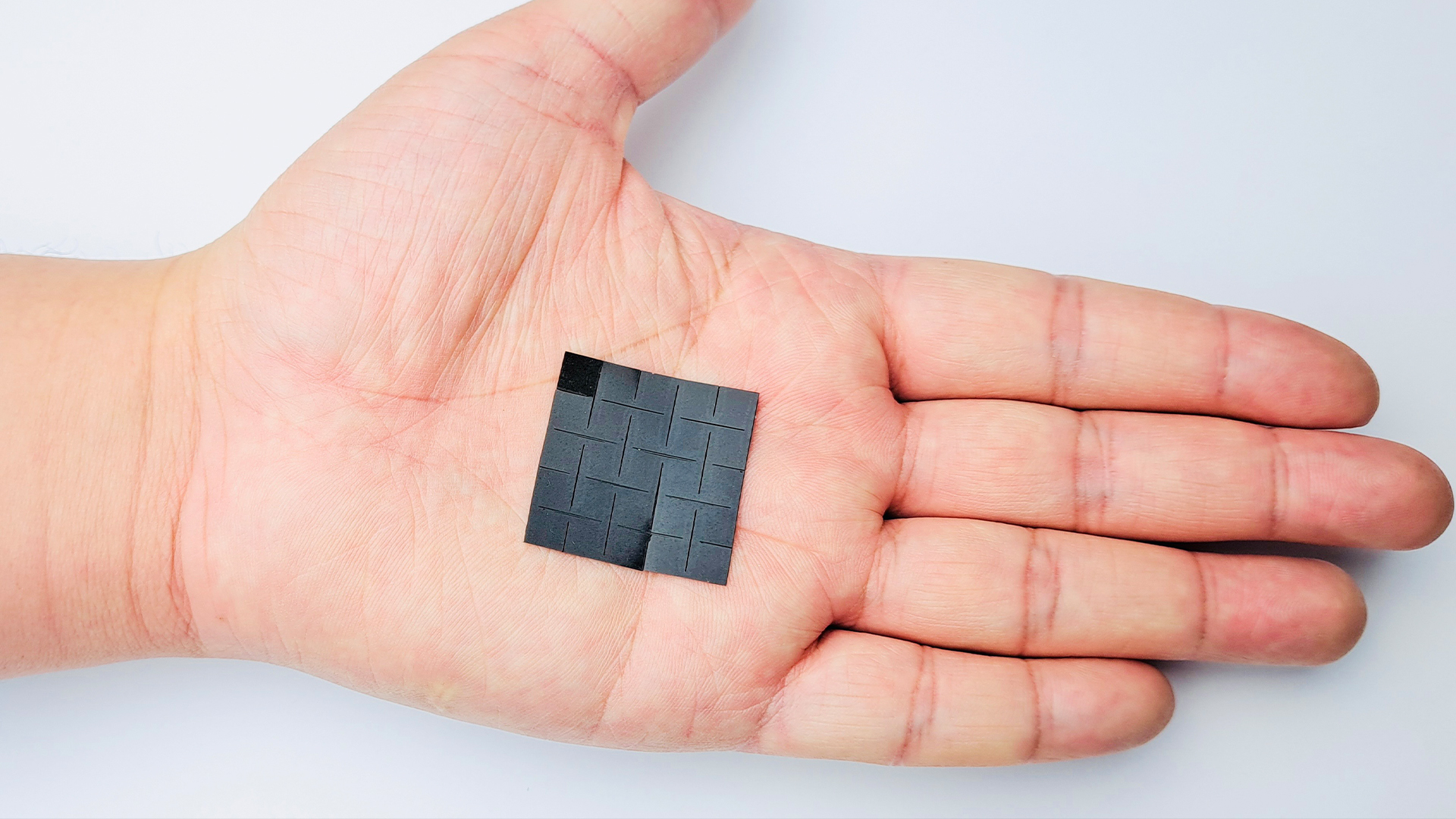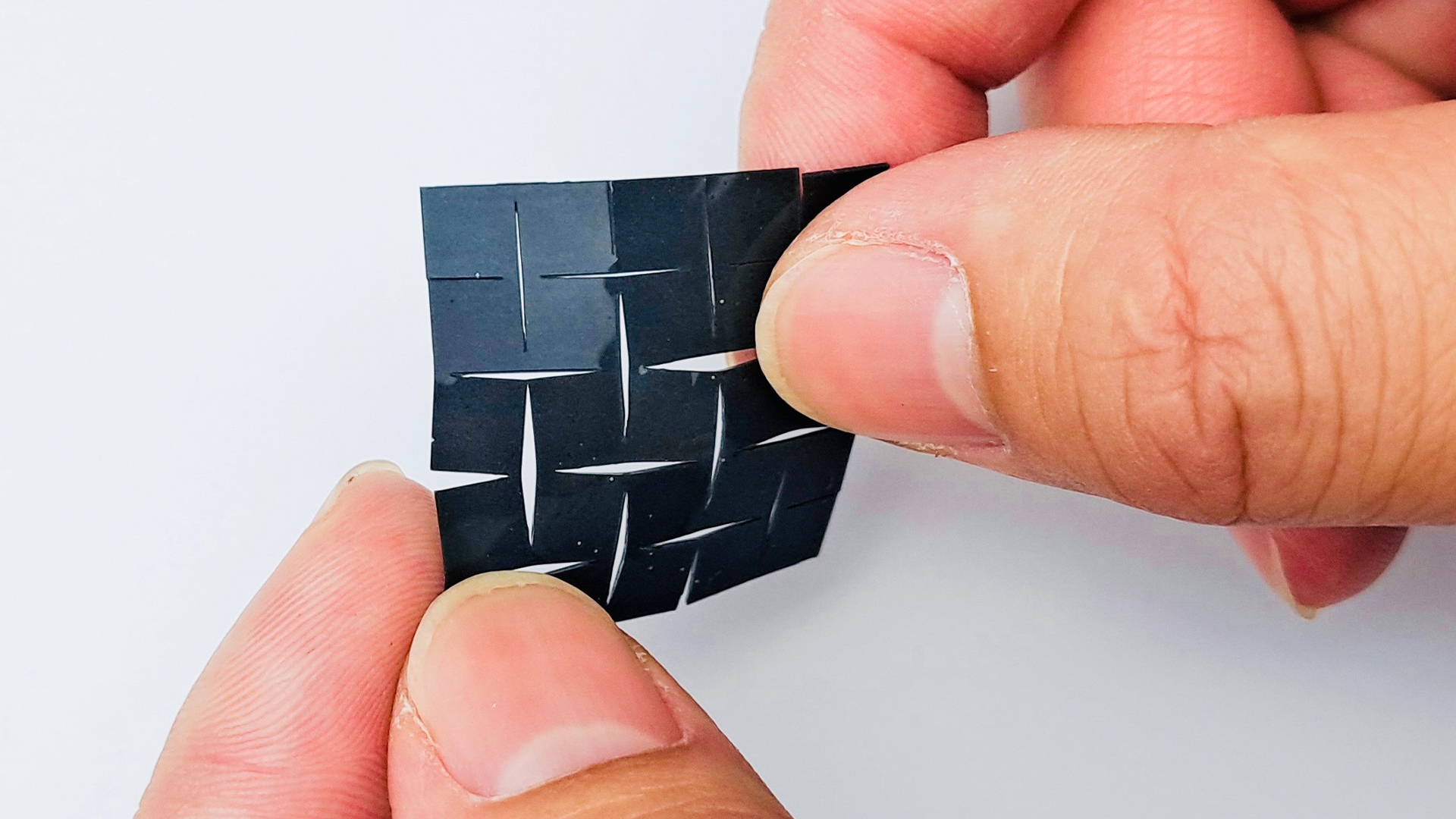New self-powered throat patch could help people speak without vocal cords
The patch might offer a non-invasive communication tool for people who cannot speak due to vocal cord problems.

A new, flexible device that clings to the neck can translate muscular movements into speech, enabling people to talk without using their vocal cords.
The small patch not only detects the movements of the throat associated with speech, but also harnesses that movement to generate electricity, meaning the device can be operated without a battery or being plugged in.
The device, described in a study published Tuesday (March 12) in the journal Nature Communications, could theoretically help people with voice disorders caused by damaged or paralyzed vocal cords communicate, including those recovering from throat cancer surgery.
Lead study author Jun Chen, an assistant professor of bioengineering at the University of California, Los Angeles, told Live Science that the idea for the patch arose after he'd spent several hours lecturing and felt his voice becoming tired. He began to imagine a way to solve this problem, to make it possible for a person to speak without using their vocal cords, also known as "vocal folds."
Related: Brain-computer interface helps patient with locked-in syndrome communicate
That thought led Chen and his colleagues to design a soft patch that might enable people to speak when they've lost that ability or are recovering from a transient vocal disorder.
The patch's design relies on research published in 2021 in the journal Nature Materials, as well as previous materials research, said Chen, who was the senior author of that 2021 study.
Get the world’s most fascinating discoveries delivered straight to your inbox.
Since the mid-19th century, scientists have known that the magnetic properties of some rigid metals can be changed when they're put under mechanical stress. An example of this is an alloy of iron and gallium, called Galfenol, whose magnetic state changes when you squeeze or deform the material. In their 2021 study, Chen and his colleagues showed the same concept could work with a soft material made of tiny magnets embedded inside thin silicon.
Now, in their latest study, the team has harnessed this material in a patch that responds to the subtle stress placed on it by the movement of throat muscles. When a person executes the movements needed to talk, the material responds by producing electrical signals that can be translated into speech.
To accomplish this, the patch is made of five very thin layers. The outer layers of the patch are made of a soft, flexible silicon material, while the middle layer, made of silicon and micromagnets, generates a magnetic field that varies with the movement of the throat muscles. The two layers surrounding it, made of coils of copper wire, translate these magnetic-field changes into electrical signals.
These electrical signals then get fed to a machine-learning algorithm that translates the pulses into speech. To train the algorithm, each participant in the study repeated five short phrases 100 times each while the program tracked their throat movements. This taught the system to associate specific movements with a given phrase.
In a demonstration of the tech involving eight people without speech problems, the algorithm was about 95% accurate at translating the patch's electrical impulses into speech. These tests were done using the same short phrases and sentences the algorithm was trained on, including "Merry Christmas" and "I hope your experiments are going well," which the individuals said while standing still, walking and running.
In different experiments, the participants were asked to speak the sentences aloud or to "voicelessly pronounce" them. These tests suggest that, in either case, the algorithm can reliably translate the muscle movements into the correct waveforms.

A close-up of the new magnetoelastic throat patch

The new patch is flexible and designed to stick to the neck.
Although these results are promising, the patch is still in the early stages of development. Its testing was limited to just the eight people saying a few phrases, and it has yet to be tested in people with speech disorders. Chen said another limitation is that the current manufacturing process for the patch would need to be scaled up and made more efficient for a large number of patches to be produced.
Looking ahead, the researchers also want to increase the device's ability to translate sentences, Chen added.
According to a 2005 survey published in the journal Laryngoscope, about 30% of people will have at least one voice disorder in their lifetime. And the Cleveland Clinic reports that between 3% and 9% of people in the U.S. will experience aphonia, or lose their voice. Aphonia can manifest as hoarseness, not being able to speak above a whisper, or a total loss of the voice.
Existing technologies to help people who can't speak — such as a small battery-operated device called an electrolarynx — are often expensive or invasive, and many people can't access them. Other devices rely on translating written text or a collection of symbols into speech, which doesn't offer a direct replacement for talking. If proven effective, the new patch could make assistive technology like this more convenient and less invasive, the authors wrote in their report.
This article is for informational purposes only and is not meant to offer medical advice.
Ever wonder why some people build muscle more easily than others or why freckles come out in the sun? Send us your questions about how the human body works to community@livescience.com with the subject line "Health Desk Q," and you may see your question answered on the website!

Rebecca Sohn is a freelance science writer. She writes about a variety of science, health and environmental topics, and is particularly interested in how science impacts people's lives. She has been an intern at CalMatters and STAT, as well as a science fellow at Mashable. Rebecca, a native of the Boston area, studied English literature and minored in music at Skidmore College in Upstate New York and later studied science journalism at New York University.


